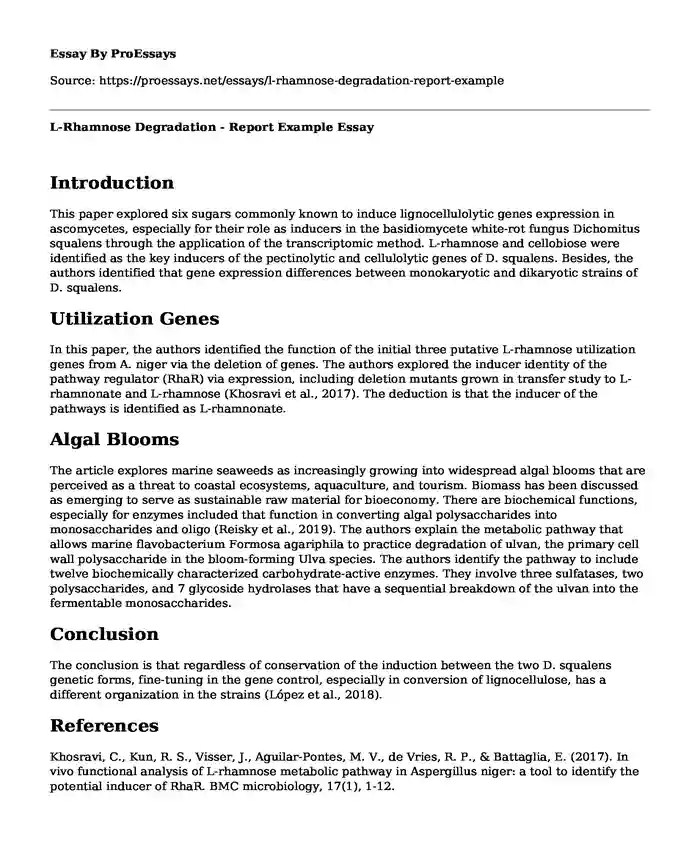Introduction
This paper explored six sugars commonly known to induce lignocellulolytic genes expression in ascomycetes, especially for their role as inducers in the basidiomycete white-rot fungus Dichomitus squalens through the application of the transcriptomic method. L-rhamnose and cellobiose were identified as the key inducers of the pectinolytic and cellulolytic genes of D. squalens. Besides, the authors identified that gene expression differences between monokaryotic and dikaryotic strains of D. squalens.
Utilization Genes
In this paper, the authors identified the function of the initial three putative L-rhamnose utilization genes from A. niger via the deletion of genes. The authors explored the inducer identity of the pathway regulator (RhaR) via expression, including deletion mutants grown in transfer study to L-rhamnonate and L-rhamnose (Khosravi et al., 2017). The deduction is that the inducer of the pathways is identified as L-rhamnonate.
Algal Blooms
The article explores marine seaweeds as increasingly growing into widespread algal blooms that are perceived as a threat to coastal ecosystems, aquaculture, and tourism. Biomass has been discussed as emerging to serve as sustainable raw material for bioeconomy. There are biochemical functions, especially for enzymes included that function in converting algal polysaccharides into monosaccharides and oligo (Reisky et al., 2019). The authors explain the metabolic pathway that allows marine flavobacterium Formosa agariphila to practice degradation of ulvan, the primary cell wall polysaccharide in the bloom-forming Ulva species. The authors identify the pathway to include twelve biochemically characterized carbohydrate-active enzymes. They involve three sulfatases, two polysaccharides, and 7 glycoside hydrolases that have a sequential breakdown of the ulvan into the fermentable monosaccharides.
Conclusion
The conclusion is that regardless of conservation of the induction between the two D. squalens genetic forms, fine-tuning in the gene control, especially in conversion of lignocellulose, has a different organization in the strains (López et al., 2018).
References
Khosravi, C., Kun, R. S., Visser, J., Aguilar-Pontes, M. V., de Vries, R. P., & Battaglia, E. (2017). In vivo functional analysis of L-rhamnose metabolic pathway in Aspergillus niger: a tool to identify the potential inducer of RhaR. BMC microbiology, 17(1), 1-12.
https://doi.org/10.1186/s12866-017-1118-z
López, S. C., Peng, M., Issak, T. Y., Daly, P., de Vries, R. P., & Mäkelä, M. R. (2018). Induction of genes encoding plant cell wall-degrading carbohydrate-active enzymes by lignocellulose-derived monosaccharides and cellobiose in the white-rot fungus Dichomitus squalens. Applied and environmental microbiology, 84(11). DOI: 10.1128/AEM.00403-18
Reisky, L., Prechoux, A., Zühlke, M. K., Bäumgen, M., Robb, C. S., Gerlach, N., ... & Song, T. (2019). A marine bacterial enzymatic cascade degrades the algal polysaccharide ulvan. Nature chemical biology, 15(8), 803-812. https://doi.org/10.1038/s41589-019-0311-9.
Cite this page
L-Rhamnose Degradation - Report Example. (2024, Jan 01). Retrieved from https://proessays.net/essays/l-rhamnose-degradation-report-example
If you are the original author of this essay and no longer wish to have it published on the ProEssays website, please click below to request its removal:
- Effect of Temperature on Enzyme Activity
- Laboratory Report on CAT Hydroelectric Power Experiment Paper Example
- Essay Example on Jawed Fish: Evolution of Jaw-mouth Vertebrates
- Essay Example on Science: Explaining Phenomena and Practical Issues
- Essay Example: Non-Renewable Resource Depletion & Sustainable Development Models
- Protecting Endangered Species - Essay Sample
- Innate Ambition: Unveiling the Nature of Human Drive for Success - Free Paper Example







